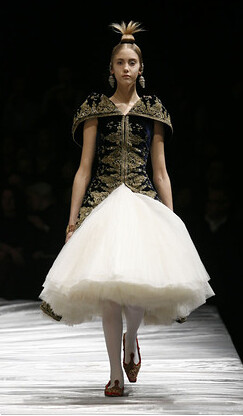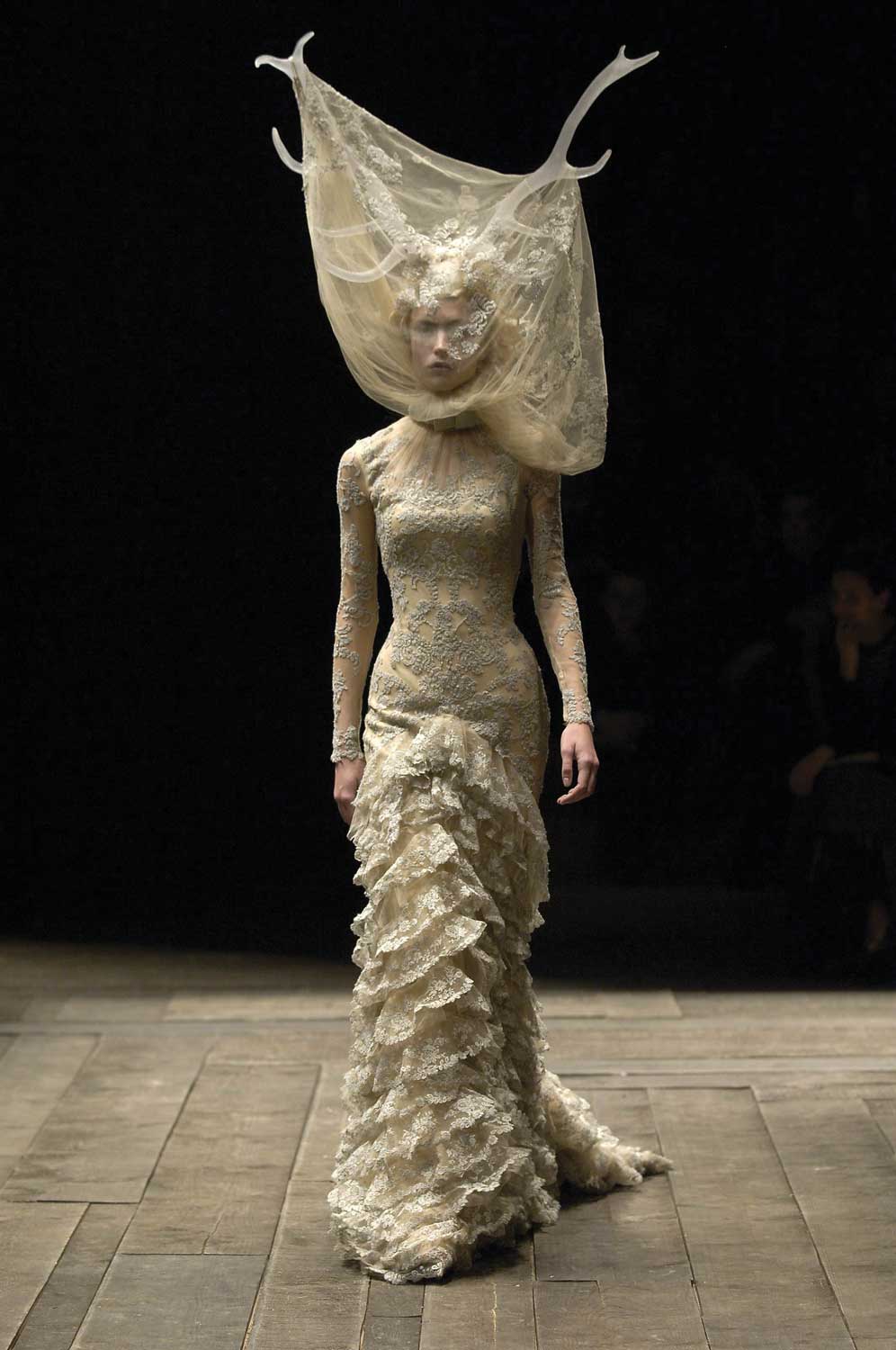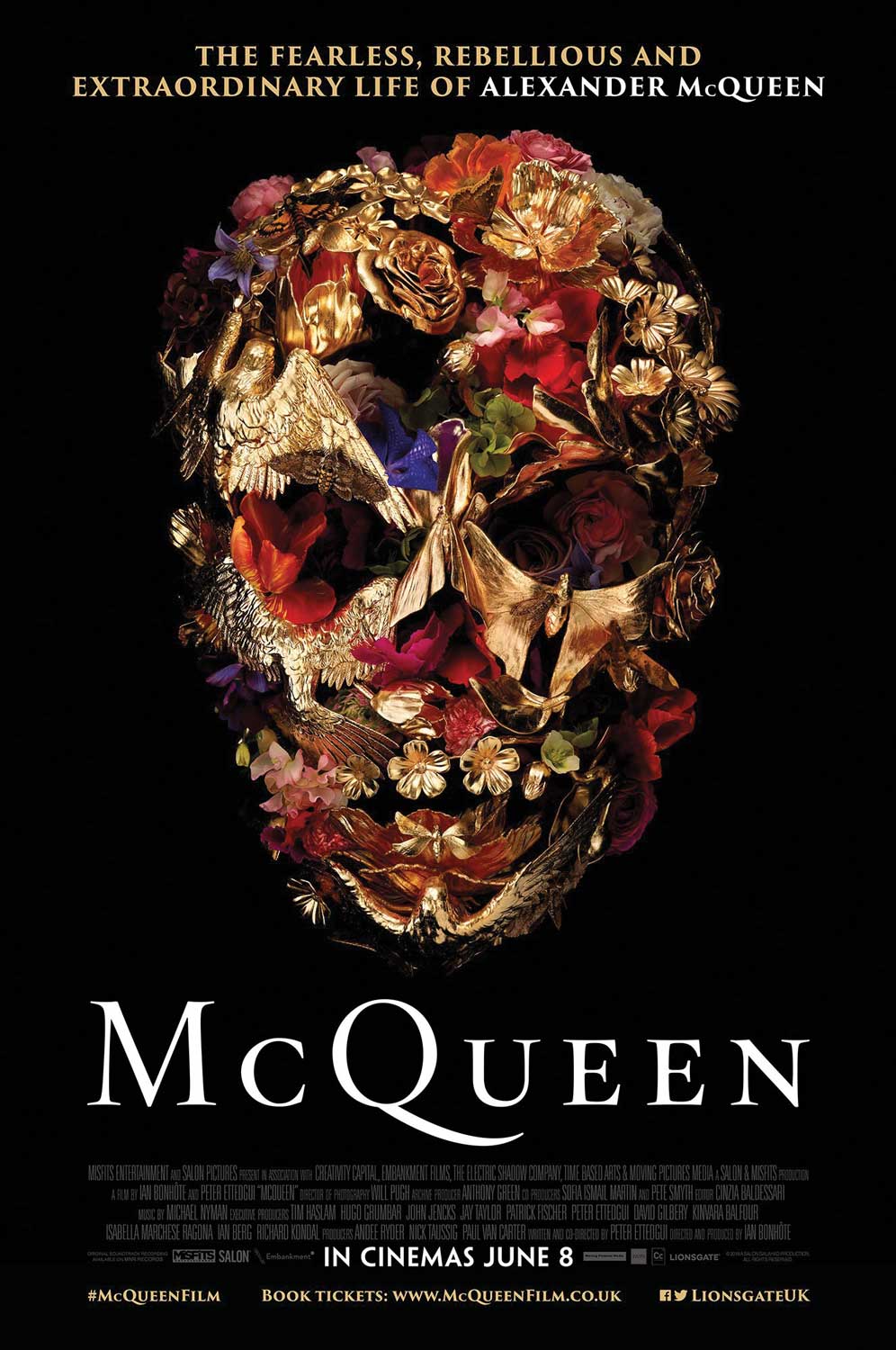CHANGING THE GAME
His Savage Beauty
~ by joel martens ~

Lee Alexander McQueen was different. His view of the world was utterly unique, and he would use that perspective to create stunning visions which would completely turn the fashion world on its ear. His avant-garde work was unconventional, his collections and shows breaking rigid patterns so long held by legacy houses like Givenchy, Chanel and many others and would move fashion off the runway and into the realms of fine art. As he said himself, “Fashion is a big bubble and sometimes I just feel like popping it.” This he did, integrating his incredible garments into wildly themed shows filled with darkness and light, rich sounds and visceral experiences, creating an emotional power that would leave audiences and critics alike, stunned and overwhelmed.
Born and raised in East London’s working-class Stratford neighborhood, nothing in his background would hint at the upcoming future for this fashion maven. The youngest of six children, McQueen’s destiny was to become a plumber, a bricklayer or a cab driver like his father. Instead, his fierce romanticism helped this lad from the East End of London become one of the most original and influential artists of his time. From his apprenticeship at an old-school Savile Row tailor and haberdasher, McQueen would make his way onto the world’s stage, and much like his early training, deconstruct garments, tearing them down to their very base and rebuilding them with his febrile imagination.
Filmmakers Ian Bonhôte and Peter Ettedgui have created a portrait of McQueen that is intimate, deeply respectful and multi-faceted, featuring one-on-one interviews with family, friends and colleagues, previously lost video of McQueen himself, as well as footage from his famed live runway shows: “Jack the Ripper Stalks His Victims,” his 1992 graduate college collection; “Highland Rape,” his most controversial early show; “Search for the Golden Fleece,” and his first collection for fashion giant Givenchy; “Voss,” an exploration of beauty and madness.
Ian Bonhôte sat down with The Rage Monthly to discuss the documentary’s highlights, as well as the pivotal moments in the designer’s life and career before his untimely death at 40-years-old.
I’ll start with where you came up with your initial idea to do a biopic on Lee Alexander McQueen?

It wasn’t the most glamorous, the way we came to the film. Lee Alexander McQueen moved to London in the ‘90s and became such a relevant figure at the time. He was one of those guys who wasn’t like other designers, because he collaborated with music and had a broader design ideology. He was obviously prominent in fashion, but it was at a time where there was a sort of democratization around consuming fashion. It wasn’t just about Vogue anymore. There were a lot of new magazines in the UK: iD, The Face, Dazed and Confused—he was one of the darlings for all of those guys—he was the same generation so he sort of grew up with them. The fashion leaders of some of those magazines were also some of his stylists, et cetera, et cetera, so they and the public would consume and live off his creativity constantly.
As a young creative person having immigrated to the U.K., that always stuck with me over the years. Some cool producers called me up having come out of a meeting and said, “Look, they were potentially talking about doing a McQueen film.” They didn’t end up making the film with us, but asked if I would be interested in it. I of course said, “Yes, definitely.” I then got in touch with Peter [Ettedgui] and he agreed and we started brainstorming. Peter went away and wrote and I created a sort of visual package for it and we went to pitch it. It wasn’t until then that we realized that people really wanted it. We managed to raise the finances and then we went on to make the film.
There are several things that were really striking to me. One was all the archival footage you managed to include. I mean was that all acquired from one place or did you have to hunt and peck for all of it?
Literally, hunt and pecked for all of it. When we went to actually raise money—many times with documentaries people expect you to have some sort of contributor’s arrangement, or a honey pot of moolah—we had none of that. We just had a very strong idea of the structure we were going to do about the film and decided to tell the story in six chapters. We ended up with five, which we called tapes because of a happy accident of finding footage about Lee.
We ended up having to look at between 170 to 200 archive sources, and every time we interviewed someone we asked if they had pictures, footage or tapes. We constantly reviewed his shows or behind the scenes footage, would see another camera and then would try to track back that source. We searched online for anyone who edited a piece of film, like an homage over one minute then we tracked that person, too. It was very much an investigation.
Lee always said, If you want to know me, look at my work.” You can tell the story of Lee through all of his work, so, we thought “Let’s put his work right at the center of our storytelling structure.” So that’s how we chose the format. We obviously tried to go for the most amazing shows, but we tried to combine what could potentially lead us to look back into his life or look forward into his life the most.
I do remember McQueen’s work very vividly. What I didn’t really understand was how much he completely altered that industry during that time period. His designs were so outside the realm of what the world had experienced up until that point. He changed the fashion world completely and in turn made it more about creating experiential art.
I think that’s why he broke out. I think because his shows we’re so passionate, it triggered within the audience and beyond, deeply emotional reactions. It allowed people who may not have been attracted to fashion, to actually like his work. Lee always said, “If you want to know me, look at my work.” The Savage Beauty Met show and his collections proved that if you manage to reach a million people and break the fashion mold, you’re going to attract people who have nothing to do with fashion. People look at his work now like they would look at a Picasso or would listen to classical music or even a rock concert or pub concert or go raving… he had that ability to tap into a lot of the cultural and people’s creative psyche.
McQueen transferred haute couture, it just blew my mind that all of it came out of one person’s head. He walked such a fine line between darkness and light…He was a raw nerve and it came out in his work. Were you aware of that sort of mania as you were going through the process, or was that something that spoke to you as you got into it more?
 The lightness and the darkness very much spoke to us from the start. Though, as we talked to people, you do make more sense of it and you get closer to the core of the person and understand how it potentially might lead you to his creativity. What’s incredible as well, is that Andrew Groves, one of McQueen’s boyfriends at the time really said it, “You know you just fell in love with the naughty boy… you know, the guy that would play pranks on you.” I think even on a day-to-day basis the people who knew Lee, would be surprised by his creative madness. He was very down to earth and could be very vulgar and very naughty and get depressed… at his core he was a working class boy and that contrast really attracted us. How can you be this person and manage to create such beauty? It’s very humbling and actually teaches us that you can’t judge a book by its cover.
The lightness and the darkness very much spoke to us from the start. Though, as we talked to people, you do make more sense of it and you get closer to the core of the person and understand how it potentially might lead you to his creativity. What’s incredible as well, is that Andrew Groves, one of McQueen’s boyfriends at the time really said it, “You know you just fell in love with the naughty boy… you know, the guy that would play pranks on you.” I think even on a day-to-day basis the people who knew Lee, would be surprised by his creative madness. He was very down to earth and could be very vulgar and very naughty and get depressed… at his core he was a working class boy and that contrast really attracted us. How can you be this person and manage to create such beauty? It’s very humbling and actually teaches us that you can’t judge a book by its cover.
Yes. When you look at Mozart, Picasso and many other creative geniuses, their skill is in tearing down tradition and rebuilding. Most people did not understand them and as with McQueen, all they saw was the out-of-the-box and sometimes crazy behavior. This film really explains a lot of the motivators behind it. Part of the key to him was understanding his family experience through his sister and his nephew, Gary. How did you connect with them and what was that process like?
We reached out to Janet (McQueen’s sister) but she said she didn’t want to take part. We knew Lee had witnessed domestic abuse because Janet’s first husband was not a great man and was violent. We didn’t want to reveal too much of that in the plot of the film, but we knew about it. There has been a lot of salacious things said about McQueen and there’s been a lot of focus on his sexuality, all of the drugs and other things. We just really wanted to take a stand and put the work at the center. If you focus on the sensational and start talking about it too much, then the movie becomes about that and we would have missed out on all his amazing work.

We started on the film, but we never took no for the final answer—we let people know we were still around if they changed their mind—but Janet never got back to us after having said “no.” We interviewed Kim who still works with Gary McQueen (nephew of Alexander McQueen) and is still his PR person. At the end of the interview she said, “Oh my god I was dreading to talk to you guys and I didn’t know why, because I really enjoyed it.” She offered to introduce us to Gary and obviously, I said I’d love to. She sent me out to a pub locally in Essex, where I met with him. I think maybe because I’m a foreigner and not into social class, we just talked very openly and I was able to tell him what I wanted to do.
After we interviewed Gary, I think two or three weeks later, Janet called asked is we would like to do a little interview with her…we were like “for sure.” I really wanted Janet to be to be comfortable, so we said don’t sign anything you just take the contract and you just see what do with it. If you feel comfortable then sign and we’ll do the film together. If you don’t like it we’ll not us it. That’s the approach we took. We felt we had to be very classy and very respectful, and people respond to that. We tried to not be too needy or too pushy mid-conversation, just remind them we’re there, but be very passive. Documentary works comes with a massive responsibility as makers, because you represent something about people’s lives and if they’ve lost someone very close to them: a brother, uncle, best friend, lover or love of their life, you want to get it right. It’s a big weight on your shoulders and you got to take the right attitude.
The film is absolutely about respecting his legacy as an artist and as a cultural icon. When you revisit things, it’s a treat because you come to understand how much of an effect a person has had on so many. McQueen affected so many people, not just in the fashion industry but culturally and socially.
I’ve seen countless treatments from commercial, music videos, couture, music, costume design, theaters that borrow from Lee’s ideas constantly. Even talking about the 2012 Olympics in London, an entire section of that opening was completely inspired by some of Lee’s work.

I had no idea, that’s amazing. His sexuality was such a part of what made him so intense. As a gay man, he was not hidden and for the time that was really powerful because sexuality used to be considered a fault or “less than.”
It’s not a defining part I think, but he knew being gay was in his DNA. I think right now it is essential not to identify anyone by any one of those things only. So many other things came first, you need to know Lee as a lover, a friend, a son, all of that makes the man. Creative people have dark and lightness and anything that can anchor us within reality—if it’s your partner, if it’s a love of something, if it’s a passion, if it’s children or if it’s your family—anything that allows you to stay within those is essential to telling the story.
That’s a really wonderful way to describe it because getting lost in his creative brilliance would be so easy to do. His inspired work was so important to the world and is what we see initially, but it was only a part of who he was…as was his sexuality.
He’s an icon and we were very keen to get the DNA of that right. A lot of gay and lesbian icons have been ripped off or have disappeared from view or died. We didn’t want it to be just an LGBT film because Lee transcended sexuality, but the LGBT community needs to be super proud of his genius and the fact he is part of the larger community. Being gay allowed him to look at things in a different way, as do a huge amount of creative people from the LGBT community. Being seven or eight percent of the society forces you to look at things from a different perspective and if society ostracizes you, then you’re going to have to find a way to create your own society. And, that is a very interesting thing.
McQueen is now playing in select theatres. For more information, go to bleeckerstreetmedia.com/mcqueen.
